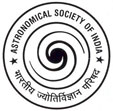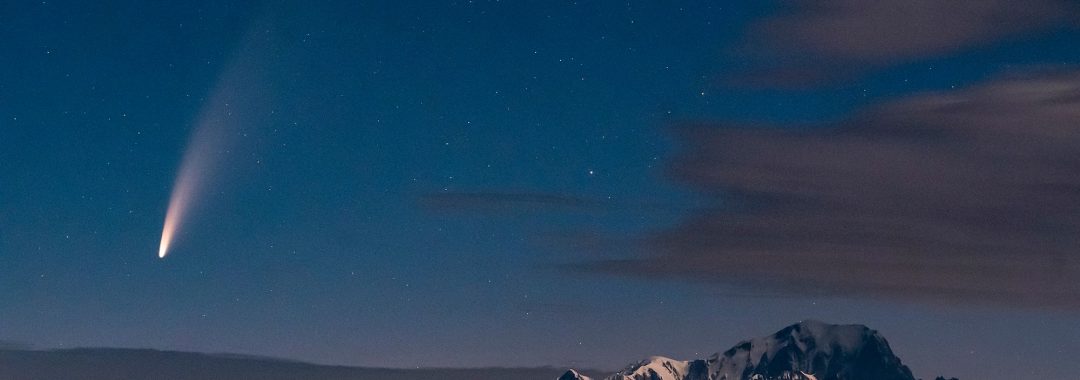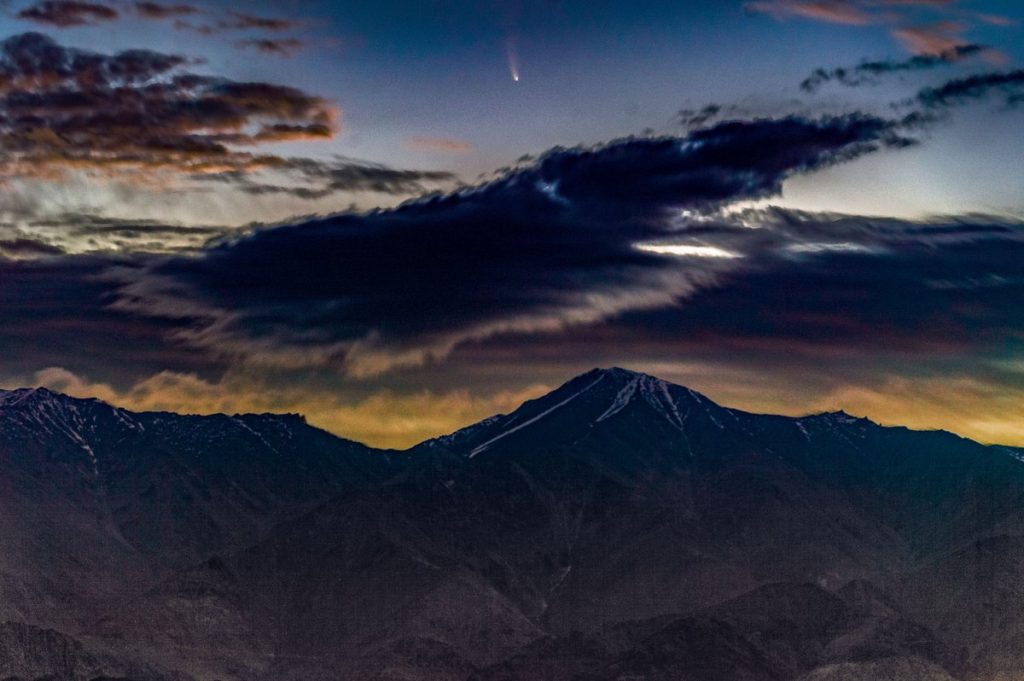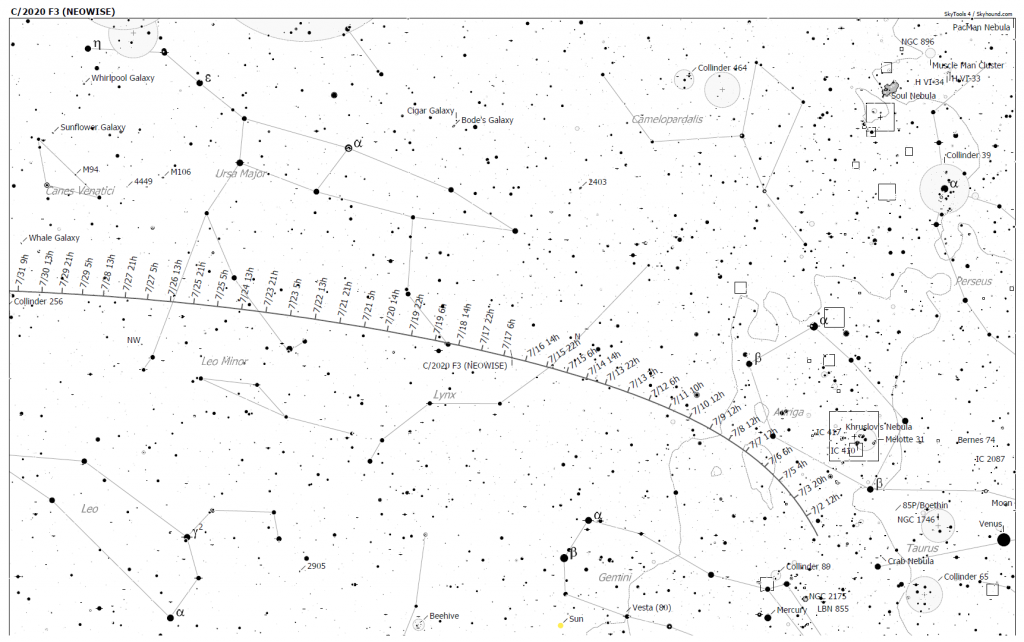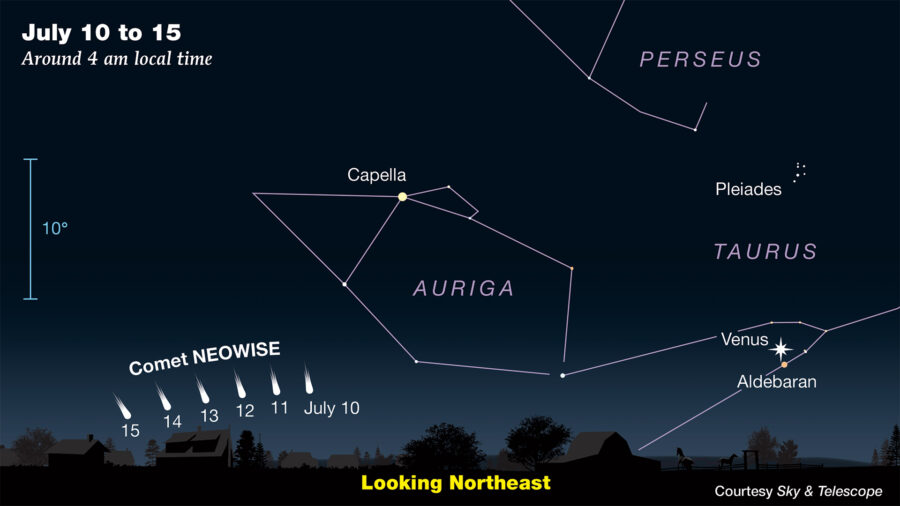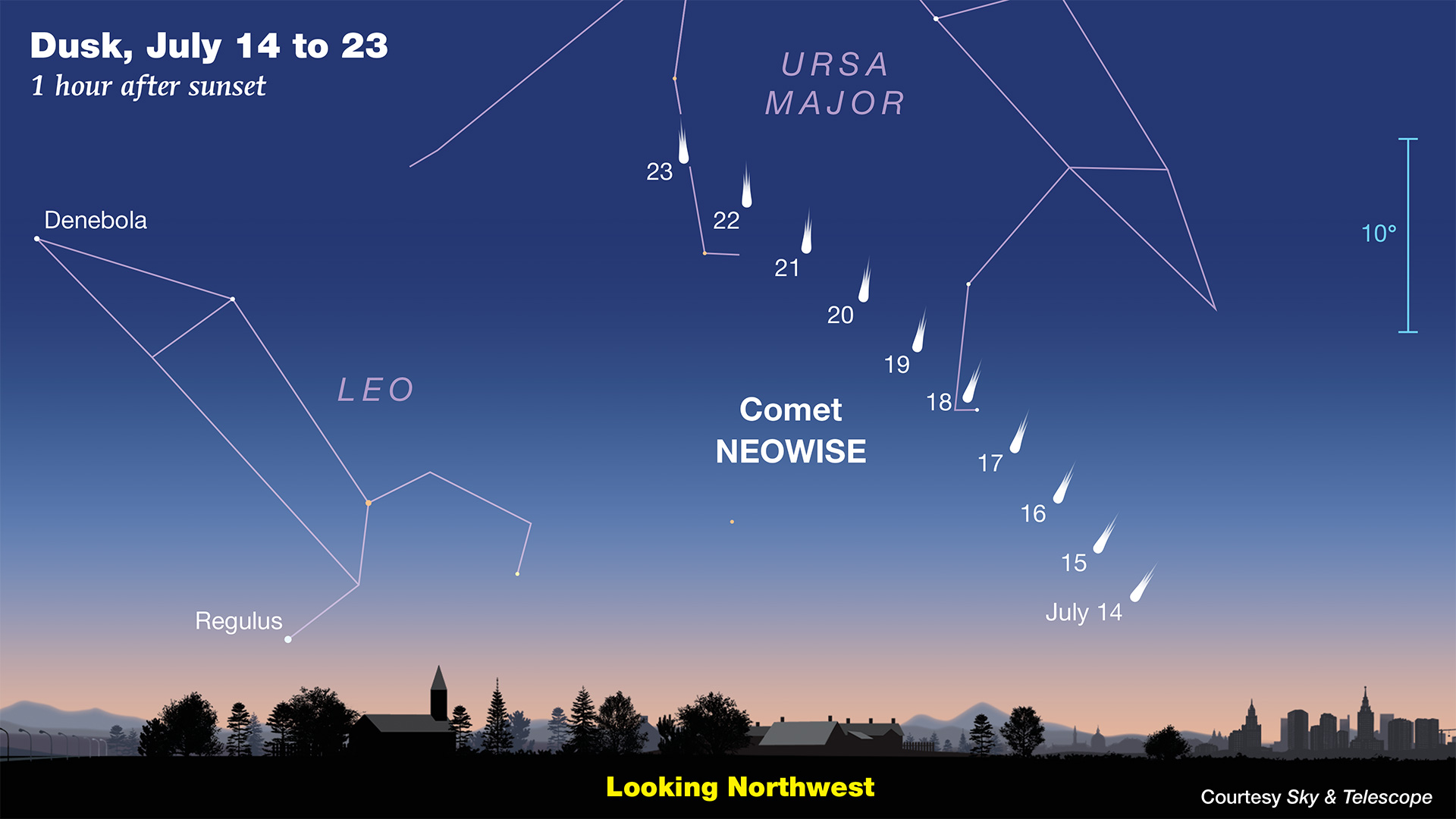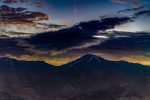This visitor to our neighbourhood is currently making the news, as it offers breathtaking views now in the dawn evening skies across the Northern Hemisphere. Called C/2020 F3 in the astronomical circles, it is a non-periodic comet which was the third discovered in late March 2020 by the space telescope instrument NEOWISE (hence the popular name).
This icy body has already finished it's closest approach to the Sun and has grown a magnificent "tail" due to vapourisation of it's components and outgasing. It is now on it's way out of the Solar system on it's huge orbit with a period of close to 5 thousand years. Although it's tail should dwindle in the coming days, it is also getting closer to the Earth, hence getting brighter. This is a unmissable sight as it's the best comet seen in a decade or so. Catch it with your binoculars for better details or take pictures to share. You can also participate in our Comet Photography Contest.
Where to see it
Earlier in July, the comet will be seen close to the horizon at dawn, towards the North-East. The bright star Capella is a good pointer to the rough direction to look at for locating the comet. The bright planet Venus will be approximately at a similar height from the horizon but much further to the East of the comet.
For the later part of July, the comet will be in the evening sky for Indian latitudes. In this case knowing the constellation of Saptarishi or the Great Bear will be useful. By the 14th of July, the comet should still be a naked-eye object and will be located below the "trapezium" of the constellation and the constellation of Leo. On the 23rd of July, the comet will pass closest to the Earth (at a more than safe distance of 54 million kilometers) and may be still bright and extended enough to be a rewarding sight. On that evening, it will also be the easiest to locate as you can join the brightest star of the "trapezium" to the star below it and extend the imaginary line towards the horizon. This line will take you near the approximate position of the comet in those 2-3 days.
The star chart above is a good resource for locating the comet in the sky. It will be useful if you know your cardinal directions and some constellations in the sky.
This linked page by "Sky & Telescope" has some more detailed help and star charts. You can see previews of them below. [Copyright ©2020 AAS Sky Publishing LLC.]
How to see it
For a morning view, you should start as early as possible after the comet "rises". Assuming you have a cloud free sky, the comet should be bright enough to see with naked eyes about 1.5 hours before sunrise. A good idea will be to to find the approximate area of location and use a pair of binoculars to survey the same. The full comet may not be visible in the "field" of the binoculars as it's tail may extend to many degrees in length.
The same applies for when the comet transfers over to the evening skies. It will however be rising "up" from the horizon as the days pass and so may be visible till later. It will be dwindling in brightness after it's close pass to the Earth on July 23rd. At a later date it's best to use binoculars for a good view.
If you are using any telescopic aid with your eyes, note that the the comet will not be as spectacular as the popular photographs. It will look fuzzier as you increase magnification. You may ofcourse attach a camera to it and capture good images of it.
Take your own pictures
Comet NEOWISE is the most exciting new comet that has come up since the 1990's. Obviously you may wish to take a picture when you spot it and share it with your friends. However, even the best photography equipment may need some fine tuning to get a good shot.
- Use a Tripod or rest the camera on a stable base before composing and shooting.
- Switch off the flash (!) and try the "night mode" in your point and shoot or mobile camera.
- For lovely landscape composition with the comet as a part of it, use a wider (smaller ~50mm) focal length.
- To get the comet to fill the picture, you should go for a focal length of close to ~300 mm.
- For shots of things in the dark your camera may need to expose for a longer time (lower shutter speed). The comet and stars actually move in the sky and thus too long an exposure may result in them showing trails instead of a sharp image. So choose a focal length and then take a few shots of the stars at that setting to see what is the exposure for which there is no or least trail.
- Go for manual focus if possible with you camera and check sharpness with test shots.
You can find some really amazing and inspiring pictures at this webpage by Spaceweather.com.
Breathtaking Comet NEOWISE images from India
Note: These images are some of the earliest from India, and have been collected from astrophotographers without a bias. These will not be favoured over others in our Comet Photography Contest.
Some technical notes on observing
Comet Neowise having crossed its perihelion on July 3, is rapidly moving away from the sun and becoming faint. The comet that was a dazzling spectacle for many astronomers across the world was rather difficult to observe from India due to the monsoon clouds. Across the world, it was observed with naked eyes by many astronomy enthusiasts.
It passes closest to Earth on July 23, 2020, at 6:44 a.m. IST. It will be about 54 million k.m. from the Earth. But even then it will not be bright enough.
Update July 14: The comet will now be seen over the northwestern horizon after the sunset.
Brightness estimates (Apparent magnitude) of the comet are given below:
Date Magnitude
(brightness)
2020-Jul-14 3.9
2020-Jul-15 4.2
2020-Jul-16 4.5
2020-Jul-17 4.8
2020-Jul-18 5.1
2020-Jul-19 5.3
2020-Jul-20 5.7
2020-Jul-21 5.9
2020-Jul-22 6.2
2020-Jul-23 6.5
2020-Jul-24 6.7
2020-Jul-25 7.0
2020-Jul-26 7.3
2020-Jul-27 7.5
2020-Jul-28 7.8
2020-Jul-29 8.1
>> It may please be noted that it is an integrated magnitude of nucleus of the comet so the comet will actually appear fainter.
Also, it may be pointed out that even though there are monsoon clouds all over India there might just be a chance to locate the comet if the sky clears up just in time. And on the positive side, if the sky clears up - it will offer a very clear sky as all the dust and smog has been washed out by the rains. Do scan the northwestern horizon with a pair of binoculars. So here are some pointers based on your latitude.
The positions of the comet are given below for about 40 min after the local sunset.
[bg_faq_start]
For 10° latitude
Date Altitude of comet Time the
40 min after sunset Comet sets
14 Jul 2020 +13° 52' 21:15
16 Jul 2020 +18° 55' 21:55
18 Jul 2020 +24° 19' 22:30
20 Jul 2020 +29° 51' 23:00
22 Jul 2020 +35° 16' 23:25
24 Jul 2020 +40° 14' 23:35
26 Jul 2020 +44° 28' 23:45
28 Jul 2020 +47° 47' 23:45
30 Jul 2020 +50° 05' 23:45
For 20° latitude
Date Altitude of comet Time the
40 min after sunset Comet sets
14 Jul 2020 +13° 52' 21:15
16 Jul 2020 +18° 55' 21:55
18 Jul 2020 +24° 19' 22:30
20 Jul 2020 +29° 51' 23:00
22 Jul 2020 +35° 16' 23:25
24 Jul 2020 +40° 14' 23:35
26 Jul 2020 +44° 28' 23:45
28 Jul 2020 +47° 47' 23:45
30 Jul 2020 +50° 05' 23:45
For 30° latitude
Date Altitude of comet Time the
40 min after sunset Comet sets
14 Jul 2020 +13° 52' 21:15
16 Jul 2020 +18° 55' 21:55
18 Jul 2020 +24° 19' 22:30
20 Jul 2020 +29° 51' 23:00
22 Jul 2020 +35° 16' 23:25
24 Jul 2020 +40° 14' 23:35
26 Jul 2020 +44° 28' 23:45
28 Jul 2020 +47° 47' 23:45
30 Jul 2020 +50° 05' 23:45
[bg_faq_end]
